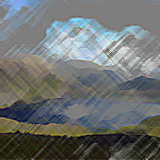NE Scotland Regional Research Framework - Upper Palaeolithic
 The Old Stone Age covers the period from the earliest appearance of people in Scotland to the end of the last Ice Age around 10,000 years BC, and the short period thereafter before the start of the Mesolithic.
The Old Stone Age covers the period from the earliest appearance of people in Scotland to the end of the last Ice Age around 10,000 years BC, and the short period thereafter before the start of the Mesolithic.
View resource assessment documents:
- Palaeolithic - list of sites for Aberdeen (version 1.0) (PDF 938KB)
- Palaeolithic - list of sites for Aberdeenshire (version 1.0) (PDF 748KB)
- Palaeolithic - map with sites
Please note that some of these documents may not be suitable or accessible for users of assistive technology such as screen readers. You can request a copy of any of these files in a more accessible format by emailing archaeology@aberdeenshire.gov.uk.
Research agenda
The research agenda gives an overview of the principle themes that research should follow in NE Scotland for the Mesolithic. The agenda has been split into different headings in order to relate them directly back to the national ScARF research headings.
History and current state of studies in NE Scotland
ScARF theme 1 key areas for future work include:
- enhancement of Historic Environment Record data for NE Scotland to ensure proper representation of Palaeolithic evidence for development control and research purposes
- analysis and publication of existing backlog of fieldwork assemblages known or likely to include Palaeolithic artefacts, including key sites and assemblages which should be prioritised
- examination of existing lithic artefacts in museums and private and commercial collections to isolate diagnostic types and to document provenances
The environment of NE Scotland
ScARF theme 2 key areas for future work include:
- examine the process of environmental change, and their resultant impact, upon NE Scotland and reconstruct the environment in the NE Scotland during this period
- examine the impact of the human presence upon NE Scotland’s environment, vegetation, and animal population
- explore the development of NE Scotland’s coastline over time and consider the impact of sea-level change on contemporary populations
- develop a predictive model for submerged site survival off NE Scotland’s coast, and focus survey for submerged sites in likely locations
The archaeological record
ScARF theme 3 key areas for future work include:
- understand the conditions during the Late-glacial period and their implications for site location and survival, in particular the major rivers and coastal plains of NE Scotland
- synthesis of existing information on tool types and site locations in the NE Scotland, and the development of a dating strategy
- recognizing the combined archaeological and palaeoenvironmental potential of late glacial kettle-holes and postglacial waterlogged deposits along river valleys
Lifestyles in NE Scotland
ScARF theme 4 key areas for future work include:
- analysis of the relationship between current inland areas and the North Sea plains, in particular the major river glens of the NE leading out to Doggerland
- further consideration of the issue of burial traditions and where they may have happened in the NE Scotland
Methodologies to be followed
ScARF theme 5 key areas for future work include:
- examination of archaeological assemblages from NE Scotland to gauge whether the procurement sites may be primary or secondary sources, and whether the raw material may represent any form of selection (flaking properties, colours and patterns)
- field work to inspect potential source locations for the raw materials used in the lithic industries
- development of work on use-wear and residue analysis for lithic assemblages and more frequent application to excavated material
- understanding the dynamics of the formation of occupation deposits as well as identifying specific craft or processing activities within sites through the application of a range of methodologies to artefactual analyses, including use wear and contextual analysis
